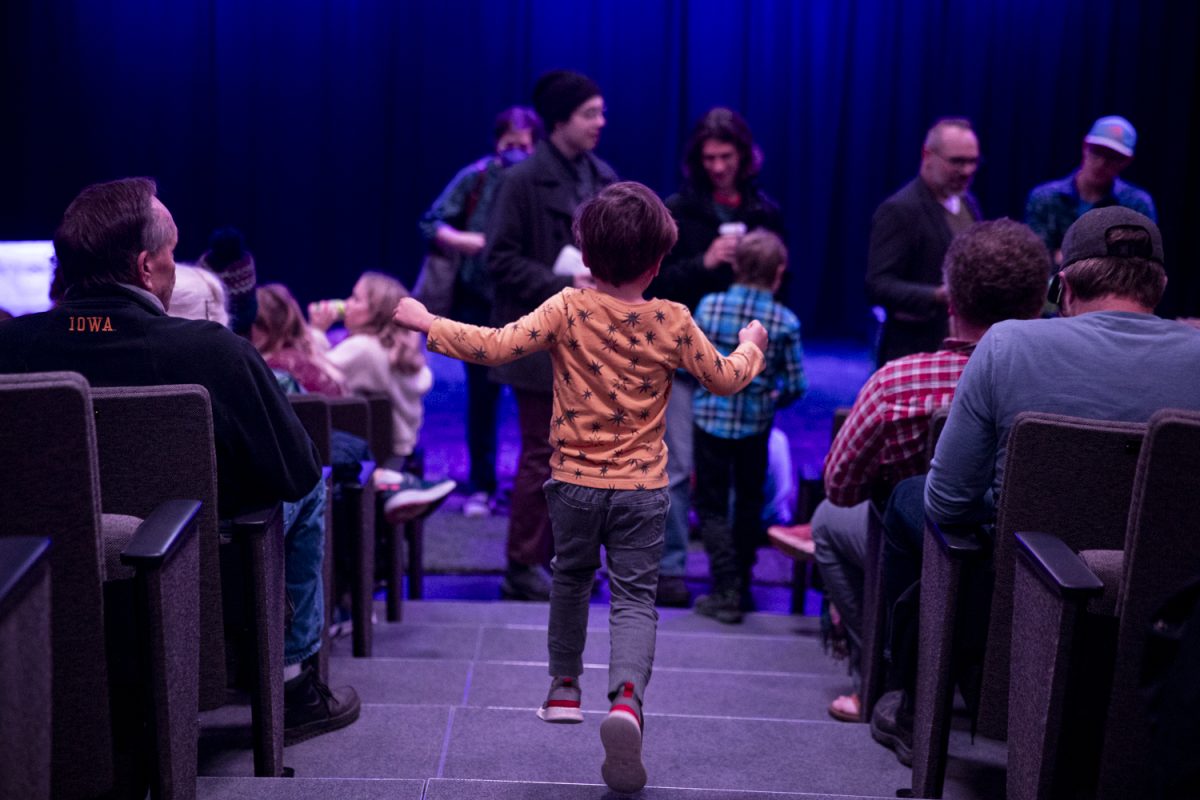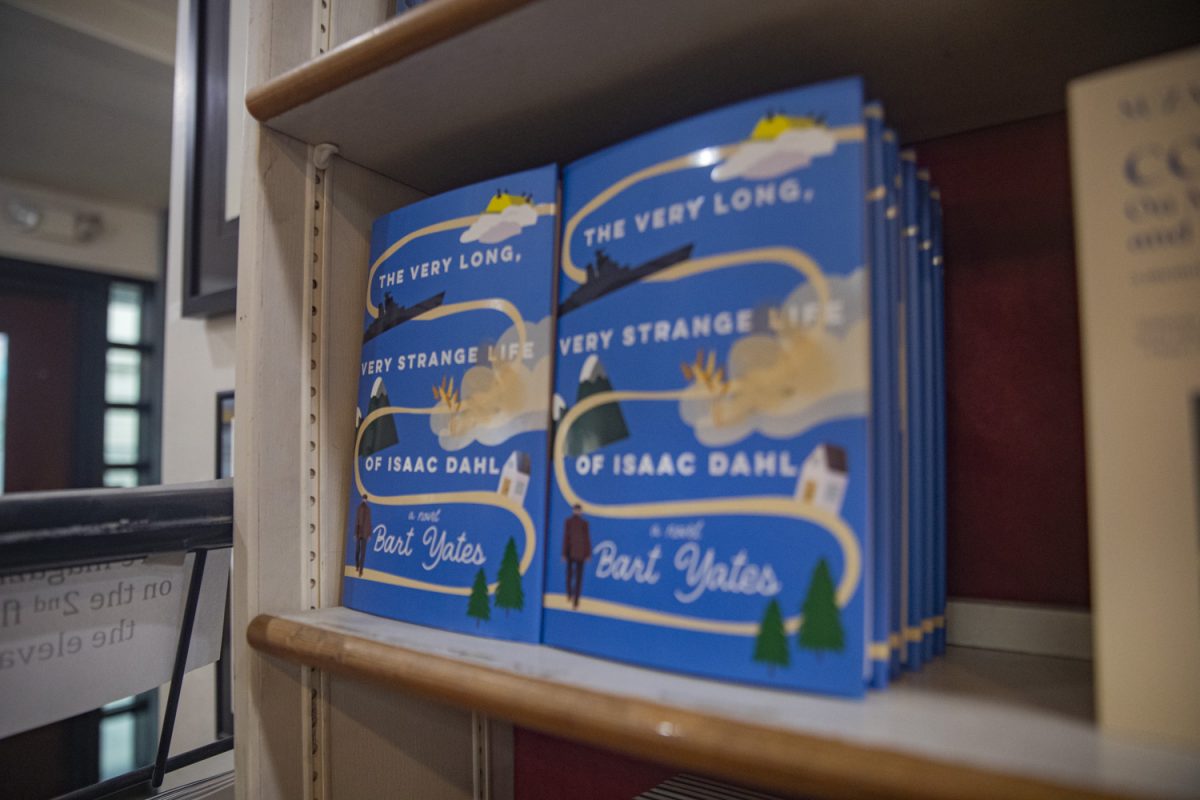Fourth-grade student Caroline Hodges wanted to create a story from her mind. She said she got pretty far and might put it to paper one day — if only she had the time and the space to do so.
She and 10 other students across the Iowa City Community School District participated in Riverside Theatre’s Playmaker Project, which is a month-long, after-school program that brought together 11 fourth- to sixth-grade students to write nine short plays.
Unlike other elementary school writing workshops, these plays would be directed and performed by professional actors on Riverside’s stage on Nov. 10-11.
Inspired by the New York-based 52nd Street Project, which has brought students and theater professionals together since 1981, Riverside’s debut program sought to develop young, artistic voices, and connect them to the larger artistic community in Iowa City.
“Not every child wants to be the one on stage, and so [this program] is a way for adults in the community to validate a kid’s creativity,” said Kathleen Johnson, the director of outreach and education at Riverside.
Student playwrights were given just a few guidelines for their plays. They had to be between eight and ten minutes, consist of two characters who would face a conflict, and must fall under an autumnal theme. Otherwise, students had complete freedom over their plays.
“[Riverside’s] feeling is that kids have this innate sense of creativity,” Johnson said. “We can help lay the foundation of what a play is and [the tools] we need to write it, then hand it over to them and let them explore it on the page.”
Caroline and fifth-grader Zaps Foster-Falk wrote a play together called “The Doll and the Cat” centered around friendship and revenge with doll and cat characters.
Before the project, Hodges said she often likes making her own mini books, and Foster-Falk shared they found their passion for writing after making comics in kindergarten.
However, for many of the students, this project was their first time writing a structured story, let alone an entire play that would be professionally produced.
“In third grade, me and another group of kids kept, like lousily writing plays at recess,” Foster-Falk said. “We always thought we would perform them but, of course, we never performed them.”
For the first four classes, the elementary students were taught about the concept of plays and playmaking with an emphasis on why plays are made in the first place. The latter half of the workshop was spent assisting the students in the creation of their plays.
Ultimately, Riverside wanted the plays to be as authentic to the playwright’s original vision as possible.
“I think it takes young writers a long time to realize that their writing can become something,” said Adrian Enzastiga, the co-instructor and director of the Playmaker Project. “I really wish something like this was available when I was growing up.”
When it came time for the students to begin writing their plays, Enzastiga shared that he and Johnson were reluctant to give direct feedback or advice to the playwrights. Instead, they would ask the writers neutral questions about their plays that would inspire them to further develop their plots and characters.
“‘How did Susan die?’ was a question I asked, and the playwright got to explore that in their play,” Enzastiga said regarding one playwright’s work, “Between Life and Death,” about an unlikely friendship between a woman named Susan and a grim reaper named Grimbo.
For the opening night performance on Friday evening, around 50 community members, friends, and family members of the playwrights occupied Riverside’s intimate theater space.
Front and center sat the playwrights whose work was about to be animated by some of the theater company’s returning performers, including Luke Brooks, Robert Kemp, Carrie Pozdol, Johnson, Orlando Lopez, Jessica Murillo Kemp, and even Riverside’s producing artistic director, Adam Knight.
Knight shared that while other theater companies do a great job of teaching kids to be on the stage, Riverside’s project has a slightly different aim.
“We want to show kids in the area that the stage is a place that can hold their stories,” Knight said.
Two decades ago, Knight had the chance to witness another project inspired by the 52nd Street Project come to fruition called the Greylock Theatre Project in Williamstown, Massachusetts. He recalled these plays being some of the most amazing pieces he had ever seen.
“Something magical happens when we validate someone’s words and stories,” Knight said.
In preparing for the production of their rendition of the 52nd Street Project, Knight, Johnson and Enzastiga decided to approach each kid’s play with respect — as if they were “Arthur Miller or Suzan-Lori Parks,” Knight said.
The actors shared a similar approach: Though some plot points or character arcs at times didn’t make complete sense, the playwrights’ out-of-the-box thinking was enough to make Murillo Kemp, a playwright herself, ask, “Why couldn’t I think of that?”
“Especially with their imaginations, wondering how they get their ideas from point A to point B throughout the play — I kind of let go of justifying the ‘why,’” Kemp said.
The plays, though all fall-inspired and limited to two characters, were vastly different from one another. From dragon enemies becoming co-rulers of the world to a love-letter triangle between the playwright and her two real-life best friends, the stories were unlike anything previously produced by Riverside.
“There’s this trained adult way of thinking linearly, and then there’s the wonderful minds of children who don’t yet have all those structures in their minds,” Kemp said. “So, it can be a wild, crazy reason for how they get from one thought to the next. As an actor, that’s the challenge.”
One commonality between these plays and the ones Riverside typically produces, however, was the visuals. The props, costumes, and lighting for the Playmaker Project plays were all recycled from previous productions.
For some plays, these elements were even upcycled. Small props were painted to resemble bricks for “The Fight” by elementary playwright Emmett Enyart, and colorful lights were used to mimic the transformation after a dark magic spell goes wrong in Rowan Hall’s “Changing Memories.”
Fourth grader Willow Krebs’ play, “The No Good Loving Bad Day,” about a love triangle between three female characters, Jinx, Misty, and Serena, was a twist on real-life events.
“It was actually about friends, but I changed it into a love,” Willow said about her writing process. “I don’t know why I did it. I just had this secret feeling inside me that wanted to break out and turn into a play.”
During the workshop, Willow was faced with the challenge of narrowing down her originally three-character play to one that could be performed by only two actors on stage. This was her first introduction to constructive criticism in a professional setting.
“[The instructors] put me back on track by tweaking a few things. They helped me in a way that kind of felt bad at first but then I thought, ‘Oh, wait, this would be a great change,’” the fourth grader said.
Willow added that, if the program were to be offered next year, she would certainly re-enroll.
With soda cans in hand for the special occasion, each playwright, seated amongst each other and some younger siblings on a bed of turf in front of the stage, cheered on their fellow creatives as their plays were performed one after another.
After every play was staged, the playwrights joined each other centerstage and embraced for one collective final bow.
Full of unique dialogue and impressive comedic timing, the elementary playwrights’ work had both children and adult audience members laughing with their full chests.
“I was blown away after the first rehearsal,” Enzastiga said. “Yes, they were written by kids, but when performed by like professional actors and directed by professional directors, they felt like regular, adult-written productions.”
While there are currently no official plans for next year’s Playmaker Project, Knight expressed that the success of the debut program meant it would hopefully be the first of many.
“[Riverside] has done over 40 world premieres,” Knight said at the project’s opening night. “Tonight, we have 11 more.”














